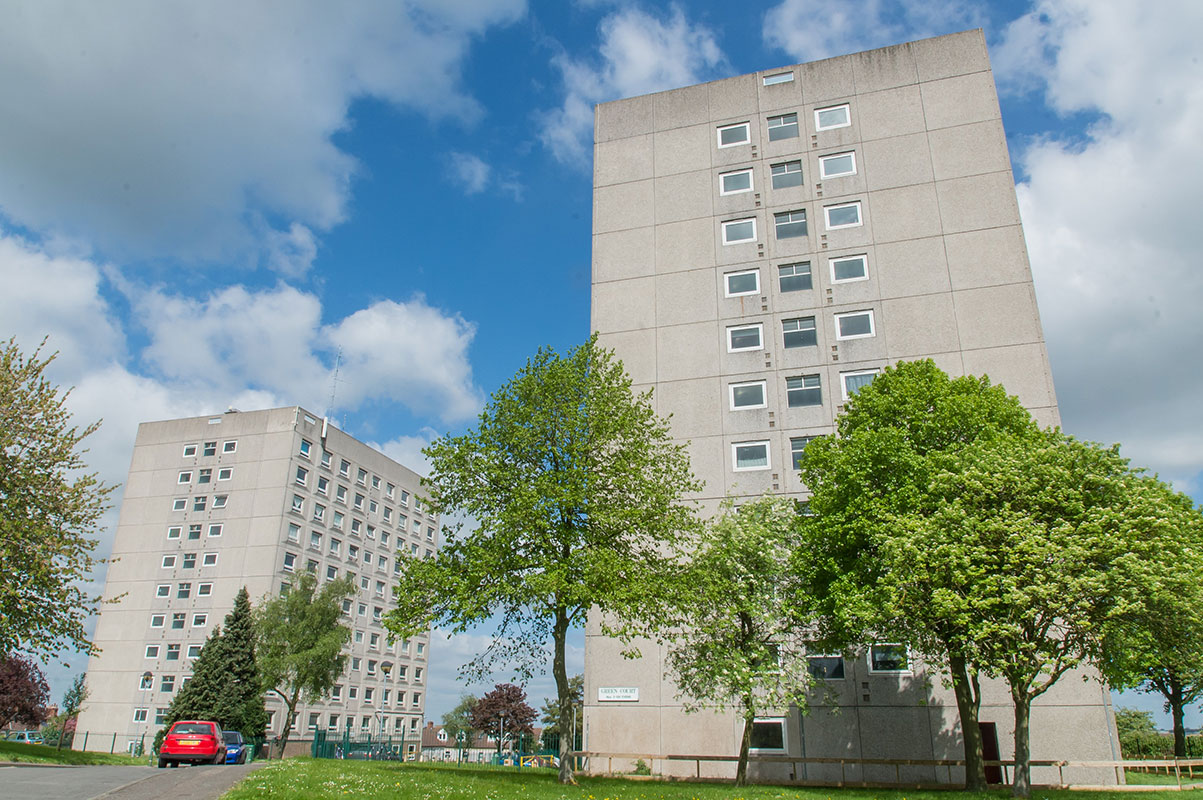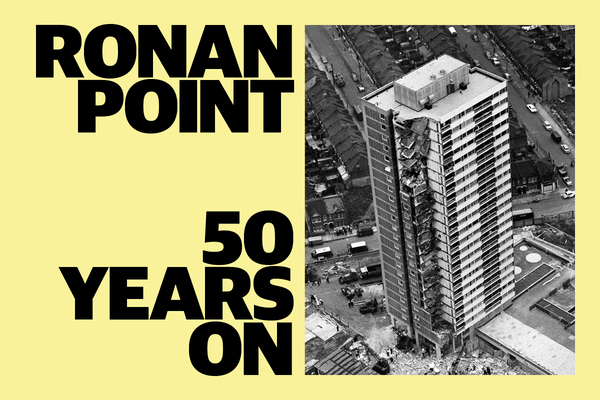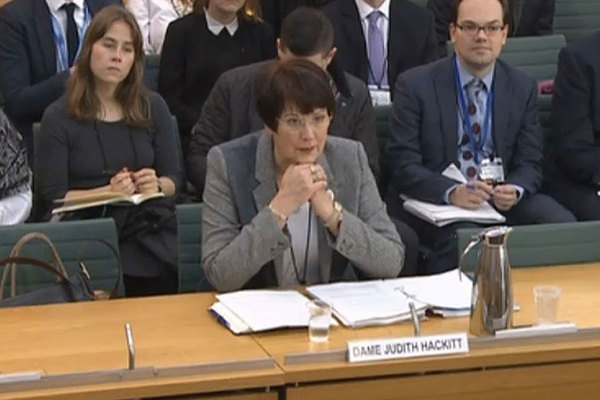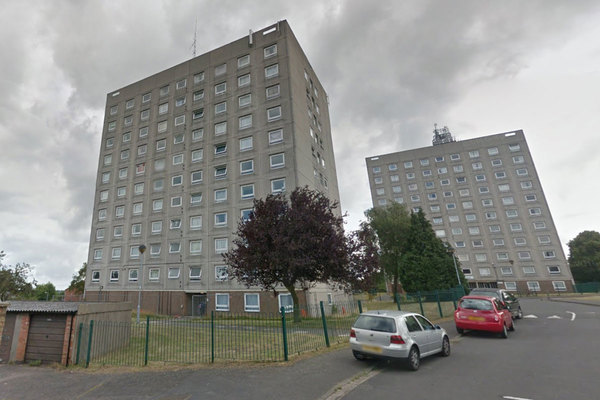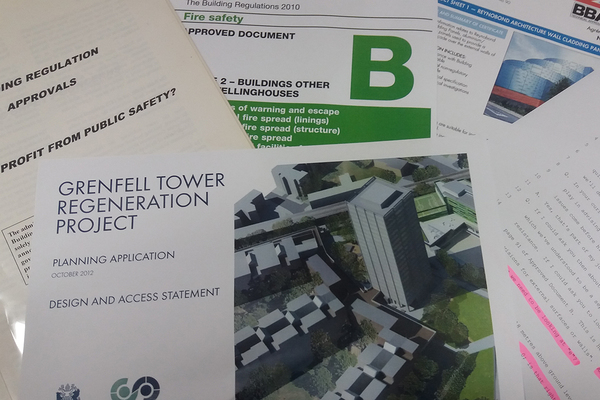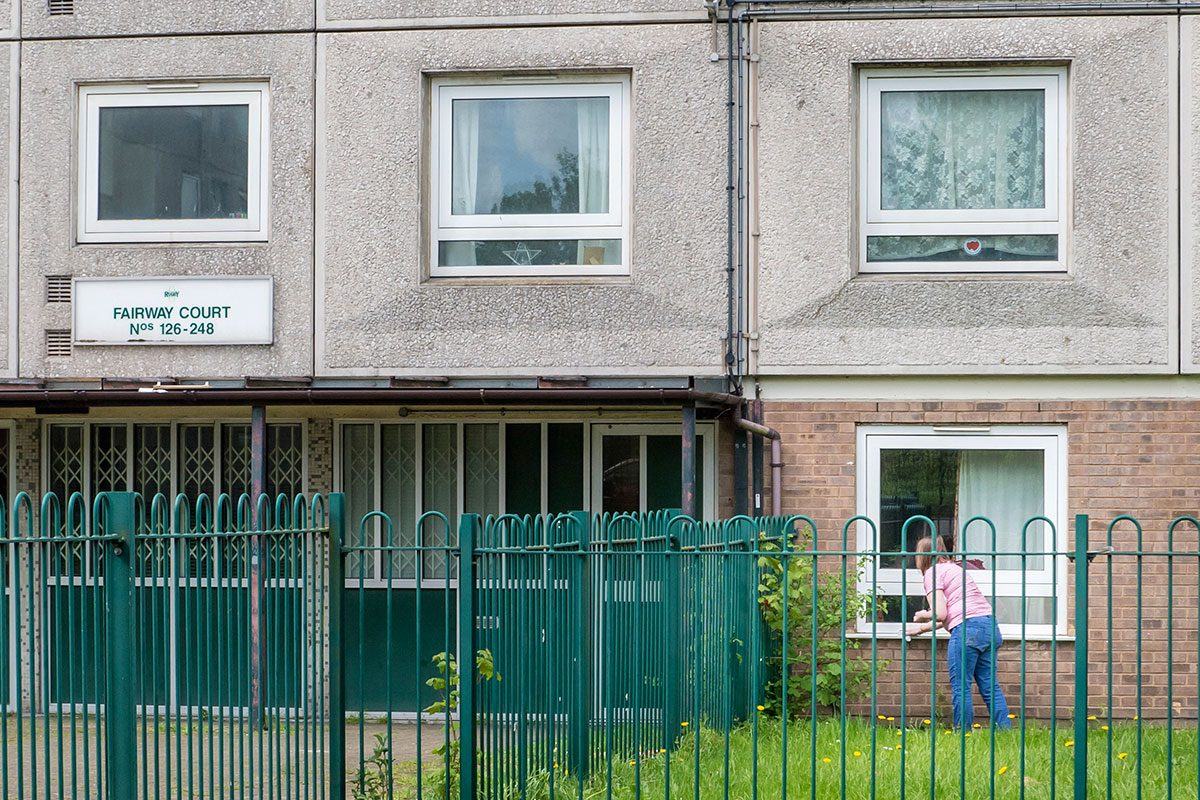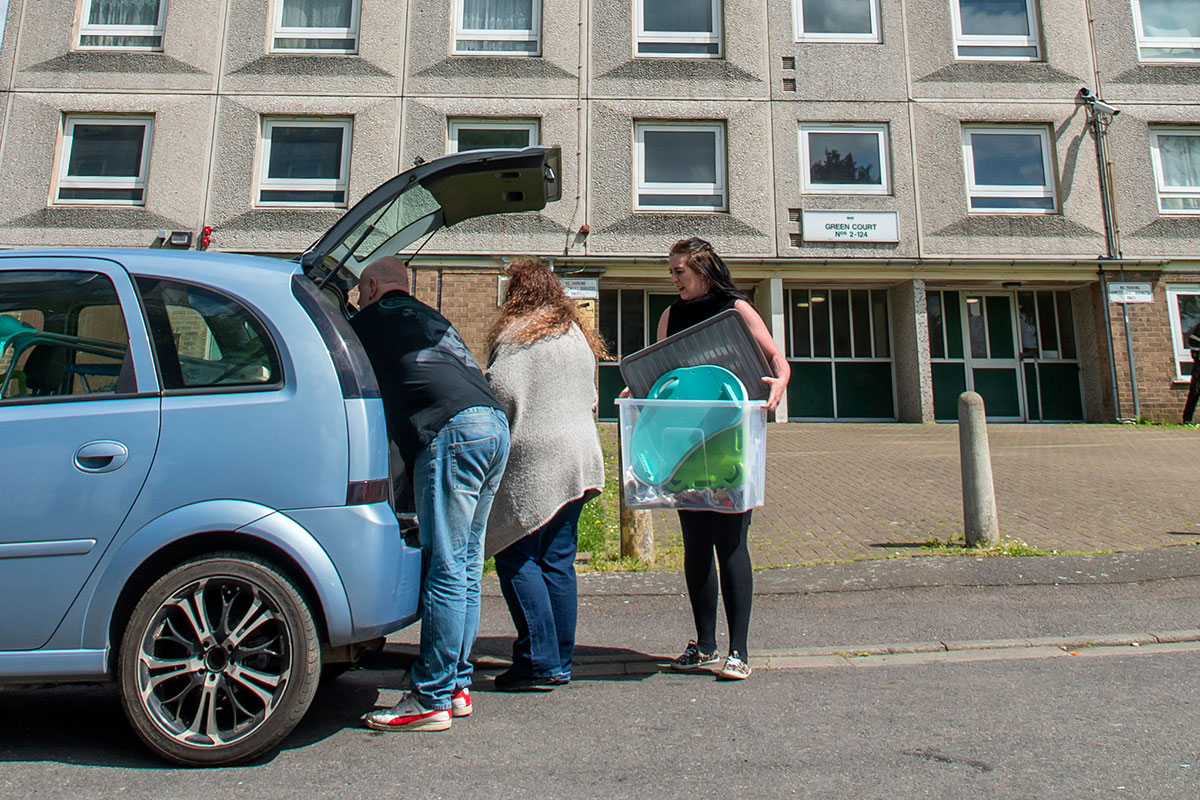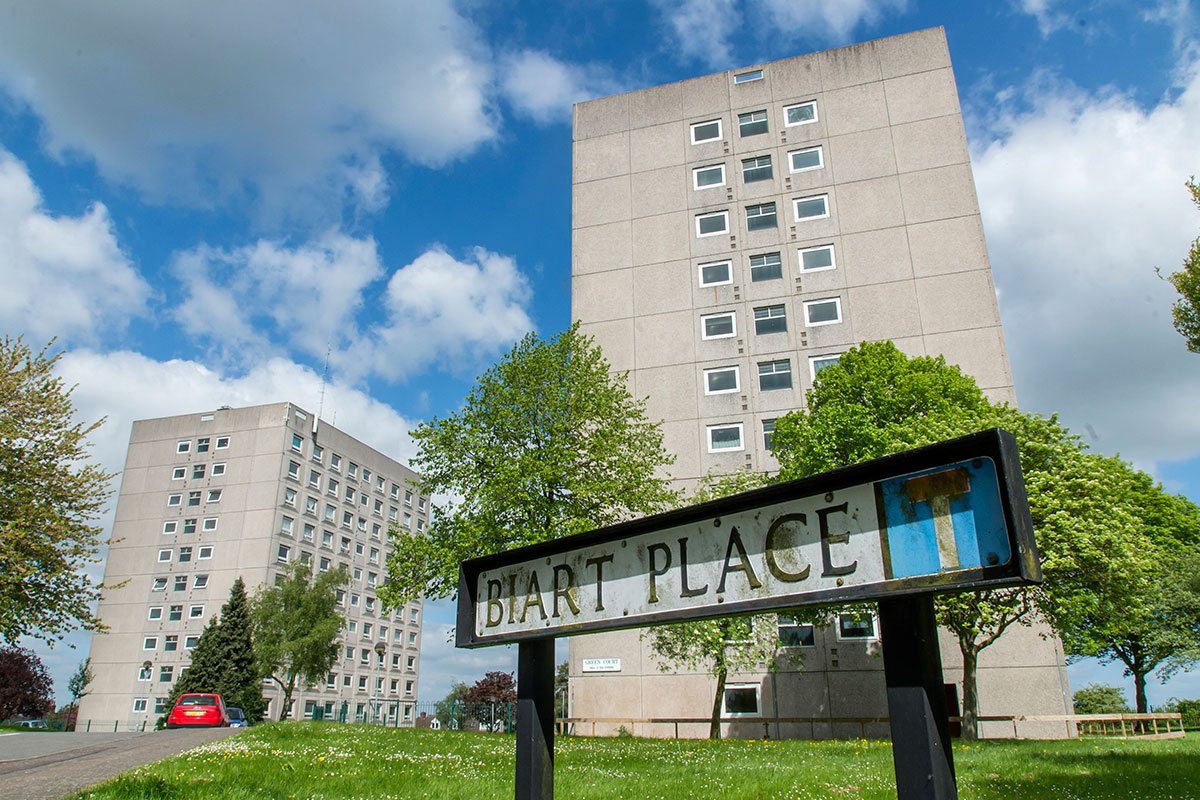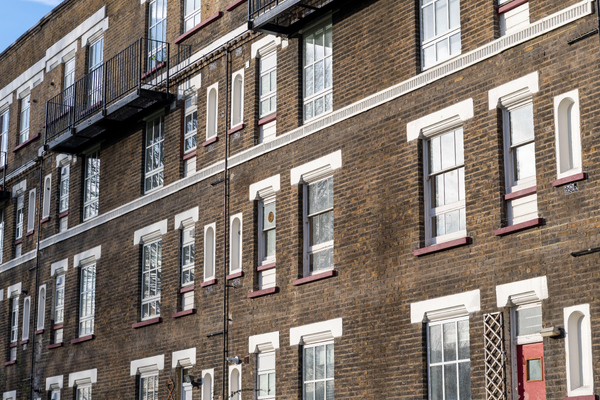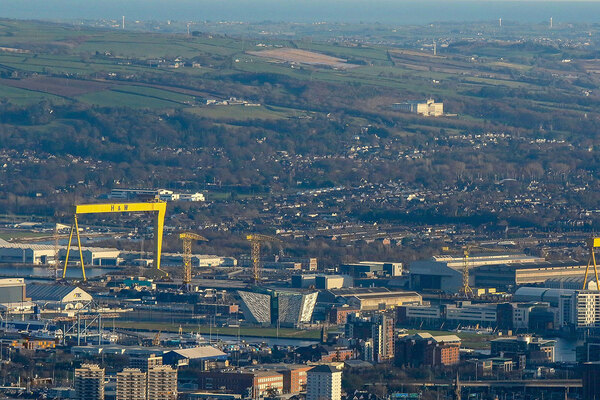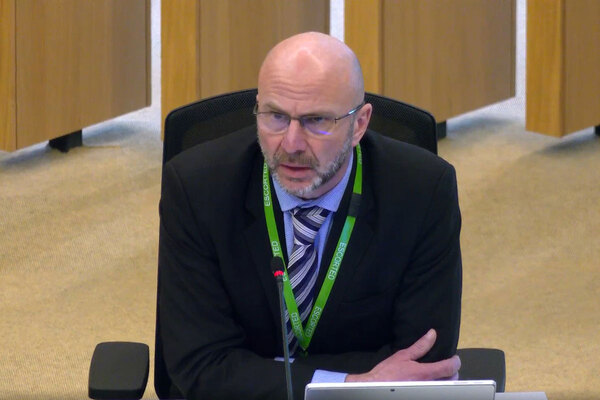You are viewing 1 of your 1 free articles
The tower blocks that time forgot
Fifty years ago councils were told to assess high-rise buildings that were similar to Ronan Point and strengthen them where necessary. So why are problems with some of the blocks still emerging? Sophie Barnes investigates. Photography by Adam Hughes/SWNS
Throughout this week we are publishing a number of articles on building safety to mark the 50thanniversary of the Ronan Point disaster
(Picture above: Green Court and Fairway Court tower blocks in Biart Place, Rugby)
A woman is washing the windows of her ground floor flat in a tower block in Rugby. It’s a Thursday morning and the only sound is birds singing.
Despite the calm, the residents of Biart Place – two tower blocks perched on a hill overlooking the town of Rugby, Warwickshire – have recently been given major news. They will have to leave their homes within weeks because the council cannot guarantee the structural safety of the blocks.
A report to Rugby Council in April following a survey found that the blocks had been built to a “poor standard” and “may not perform as expected in the event of a fire or explosion”.
The council now faces a decision: whether to demolish them or fix the problems.
They are large panel system (LPS) blocks, which have attracted attention in recent months following the discovery in south London that four of these LPS buildings had a gas supply and may not have been appropriately strengthened – a serious concern because a gas explosion could cause them to collapse. This isn’t just theoretical; in 1968 an LPS block called Ronan Point partially collapsed from a gas explosion, killing four people.
Standing outside the Rugby blocks Neil Sandison, ward councillor and one of nine Liberal Democrat councillors on a Conservative-run council, says it is the Grenfell Tower fire that has prompted councils to take a look at their own blocks. “The sad thing is that all of this has come out of Grenfell. It’s good that we know now that there are these latent defects within the blocks and we can look to either repair or replace.”
But why did it take a tragedy like Grenfell to make councils take another look at blocks that were singled out as vulnerable following the Ronan Point collapse 50 years ago? And are these large panel blocks dangerous?
"It is by no means certain, 50 years on, that they have been modified in line with the government’s requirements"
Following the Ronan Point disaster landlords of large panel blocks were told by the government at the time to assess the buildings and strengthen them if necessary. These blocks are still standing across the country but it is by no means certain, 50 years on, that they have been modified in line with the government’s requirements.
This inaction on the part of successive councils and governments was exposed (and not for the first time) last August when Southwark Council admitted it didn’t know whether its four large panel blocks – the Ledbury Estate – had been strengthened. For residents this potentially explained what they had been reporting for years: cracks in the walls, water leaks, even overhearing neighbours’ conversations through walls.
These are all common ailments in large panel blocks, where the panels can shift over time or in hot weather, causing gaps to open up.
This means that not only are there structural concerns about large panel blocks that haven’t been strengthened or assessed, there are also possible serious fire safety issues. Any cracks compromise the compartmentation of the buildings, helping fire to spread.
Even more worryingly, the four Ledbury blocks had had a gas supply for the past 50 years, meaning that at any point a gas explosion could have caused a disastrous collapse just like at Ronan Point.
"Any cracks compromise the compartmentation of the buildings, helping fire to spread"
Southwark Council officials said they couldn’t find any paperwork to show the buildings had been strengthened, because it was lost when the blocks were transferred from the former Greater London Council to Southwark’s ownership. The council is now considering whether to demolish or refurbish them.
Southwark certainly wasn’t alone in its dereliction of duty. A few months later Hammersmith & Fulham Council admitted appropriate work hadn’t been carried out on its two large panel blocks – Hartopp Point and Lannoy Point – to stop disproportionate collapse.
These blocks also had the telltale cracks. Inside Housing was shown a letter from the council in 2012 - when it was under Conservative rather than Labour leadrship - which proved officials knew about cracks in the walls, with residents reporting they could smell the cigarette smoke of their neighbours wafting through the gaps, but failed to carry out further investigations.
A resident of Biart Place washes the windows of a flat
Elsewhere, many other councils are also scrambling to catch up and carry out structural surveys of their large panel blocks, after years of inaction. Lewisham Homes, Tower Hamlets and Enfield councils and Homes for Haringey are all taking a closer look at these blocks.
Despite the uncertainty Rugby Council is one of the few landlords that has taken the bold step to move residents out of two of its blocks – Green Court and Fairway Court. The residents living in 90 flats across the blocks have been told they will be given alternative housing and will keep their secure tenancies.
This has been reported in the national media but the message doesn’t seem to have filtered down to all the residents. When Inside Housing stops one woman outside Green Court, who doesn’t want to give her name, she says the only communication they’ve had from the council is a letter to say building work will start soon and to expect some noise. She’s relieved to leave the block though, because her son struggles with his health and she says there’s damp and mould on her walls.
“The sad thing is that all of this has come out of Grenfell.” - Neil Sandison, ward councillor
Despite councils up and down the country slowly admitting that vital strengthening work on these blocks has not, or may not have, been carried out (and problems have, in truth, emerged regularly over the past 30 years), the government has so far taken a hands-off approach. Since the Ledbury scare last August one letter has gone out from the Ministry of Housing, Communities and Local Government telling the landlords of large panel blocks to make sure they are assessed.
When Inside Housing asked what the government has done to check this has been carried out and the results, given the various issues raised by councils across the country, it said it had instructed the Building Research Establishment (BRE) to update a handbook it published in 2012.
Researching and understanding this important issue is not helped by the lack of information about this type of building. It is not clear exactly how many LPS blocks still exist – some have been torn down – and the only list Inside Housing could find was drawn up by the BRE in the 1980s.
What is clear, however, is councils have not been listening to the experts. The BRE guide on LPS blocks published in 2012 states: “Block owners have an ongoing responsibility for their safety, which requires periodic inspection and structural assessment of such buildings.”
When Inside Housing sent Freedom of Information Act requests to councils asking when they last carried out a structural survey of their large panel blocks, many came back to say they had no such reports.
It seems in some circumstances councils resented having to carry out strengthening work. The BRE guide states a number of building owners felt the assessments carried out seemed to involve “unnecessary expenditure, social upheaval… owing to what were, in some eyes, not entirely justified packages of strengthening works”.
Chantelle Read and her parents load up their car with possessions as Ms Read moves out of her apartment in Green Court
John Paterson, a housing activist who has looked into LPS blocks for years, says evidence from the Ronan Point inquiry revealed “many of these system-built LPS buildings were built without a relevant code of practice, or relevant regulations”.
He says the fact the government “does not monitor the performance of local authorities with regard to advice in circulars, even after 50 years” may mean it is time to make the advice legally binding.
Back in Rugby, Inside Housing asks why it took so long to discover the blocks were not structurally sound. A spokesperson says they commissioned intrusive surveys in 2016. He adds: “The results of these surveys showed an element of doubt over the construction of the blocks that could never be established without carrying out the intrusive survey – for example, it is not possible to know whether steel reinforcement within a concrete panel is properly interlocked without removing the concrete. We commissioned further intrusive surveys that have provided much greater detail and have confirmed that the blocks were not built as designed.”
Tony Bird, who has been working with residents on the Ledbury Estate and at Hartopp Point and Lannoy Point, says the problem is councils don’t understand the buildings. “My thoughts are that they don’t have the skills to understand these types of blocks. You’re not trained about large panel systems, and they’re different from other tower blocks.”
“Block owners have an ongoing responsibility, which requires periodic inspection.” - BRE guide on LPOS blocks
Mr Bird was part of a team of three – along with retired architect Sam Webb, who led the way in getting Ronan Point demolished, and chartered surveyor Arnold Tarling, who helped Lakanal House residents following a devastating fire that killed six people in 2009 – who continually tried to warn councils about the dangers of the blocks.
At some of these tower blocks the situation has turned ugly. Mr Tarling and Mr Bird have to be escorted by security guards at the Hammersmith & Fulham tower blocks whenever they go to visit residents, and are filmed by the guards in a move they see as an intimidation tactic.
“I am continually harassed,” Mr Bird says, “and there are four or five security guards who insist on escorting me from the ground floor to the first floor. I have filmed them filming us, and I regard that as intimidation. I’ve been kettled and escorted to the door of the resident I’m visiting.”
These three experts now think the cost of strengthening LPS blocks to the required standard to make them safe might be too high.
A spokesperson for Hammersmith and Fulham Council said: "We take the issue of fire safety very seriously. We’re consulting leading fire safety experts and reassuring residents that their homes are safe. The buildings have been strengthened and there is no gas supply.
"Working with London Fire Brigade, we have introduced robust safety measures at Hartopp Point and Lannoy Point, including: 24/7 fire wardens, new smoke alarms and heat detectors in flats and communal areas. Any residents who would like to move have been offered other homes in the borough."
Rugby Council seems pretty set on a plan to demolish rather than refurbish the blocks, largely due to cost – although it has not made a final decision. It has estimated expenditure on demolishing and rebuilding to come to £25m.
The work to make these buildings safe is also complicated by the fact that they may not have been built properly in the first place. The BRE’s guide states: “Although the historically observed performance of large panel system blocks has in general been satisfactory… the potential vulnerability of this form of construction has been highlighted by the recent progressive collapse of parts of several large panel system dwelling blocks during demolition.
“The large panel system blocks concerned were pre-Ronan Point [made by] Fram Russell Large Panel System Limited. Limited investigation of one of the collapses by BRE suggested that the blocks could have been constructed to a relatively poor standard.”
As councils slowly start to realise the work that might be required to make these blocks safe, the question is: to demolish or to refurb? It is vital they make the right call.
And if we are to avoid future tragedies, it is important the government understands and keeps track of what is happening.
Ronan Point: 50 years on
We have published a series of articles to mark the 50th anniversary of Ronan Point:
Are tenants being listened to on building safety? Tower block safety campaigner Frances Clarke questions whether Dame Judith Hackitt is really listening to tenants
The tower blocks that time forgot Fifty years ago councils were told to assess high-rise buildings that were similar to Ronan Point and strengthen them where necessary. So why are problems with some of the blocks still emerging?
One man’s 50-year battle to improve tower block safety Meet architect Sam Webb, who has been campaigning on safety in tower blocks since the disaster at Ronan Point
The worrying legacy of a disaster Jules Birch reflects on what we can learn from the Ronan Point disaster
Watch a new film about Ronan Point Filmmaker Ricky Chambers, whose grandparents and mother lived in Ronan Point, has made a film telling people’s stories of the ill-fated block. Watch the film and read Mr Chambers’ comments on why he made it
The dangers of large panel system construction Building safety expert Sam Webb explains why the system of construction used at Ronan Point was flawed, and how it was used in other buildings still occupied today
